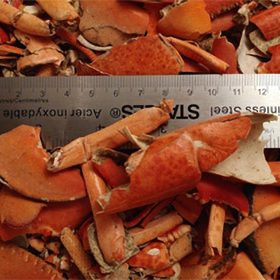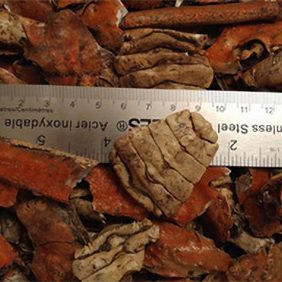About Coastal Shell Products
Coastal Shell Products is an established "state of the art" crustacean shell drying facility. We specialize in the drying of shell waste from the fishing industry of cold Atlantic Canada waters. We process Snow Crab (Chionoecetes opilio), American Lobster (Homarus americanus) and Shrimps (Pandalus borealis being the most common specie).
During the prime seasons of operation, our goal is to employ as many people as needed from the region. We are a proud partner of the seafood processing industry focused on recycling and adding value while protecting the environment. These dried cold-water seashells are the first stage transformation. Our products travel easily, and can be delivered by way of sea container or by transport trailer and are packaged in nylon bulk bags of two different sizes (4 and 8 feet tall) depending on types of products purchased.
We are recycling organic matter in large quantities, with qualities and specific attributes.
Our drying facility is a 2800 square meter building located in the quaint coastal community of Richibucto, New Brunswick, Eastern Canada. Our business potential due to our location, makes us a prime player for accessing raw material.
Our Products
Our products include fertilizer, animal feed and numerous other value-added products such as Chitin, Chitosan, Glucosamine to name a few. Our large ocean territories are pristine and unpolluted. We have excellent ocean conditions that ultimately will render much appreciated sea products. We can process large orders.
Our products can be delivered by way of sea containers or transport trailers. Dried Shells have 10% or less moisture content with less than 1% debris / waste.

Dried Lobster Shells
Lobster (Homarus americanus)*
The amount of lobster caught from our clean & cold Atlantic waters amount to more than half of the world supply. Canadian lobster, it could be said, is our most iconic Canadian export. Its thicker and harder shell makes its carapace packed with the desired elements. The wharf landings are in progression, stocks are healthy and on an upward trend.
Canadian authorities, namely the Department of Fisheries and Oceans (D.F.O.), are responsible, through management practices, for the healthy and sustainable lobster industry. They manage the resource with common sense and sound practices (limiting fishing gear or licenses, lengths of fishing seasons, lobster size restriction, etc.). Fishing seasons and zones are numerous and variable. The lobster season in Atlantic Canada is technically year-round with a decrease in catches in winter months. This crustacean is among the largest in the world, which can grow up to 60 cm in length with a body weight up to 18kg. They live up to 50 years, are mostly costal with a depth range from 40 to 200 meters.
*Information contained in this sheet is strongly inspired or partly taken from the D.F.O. Canada website.
Dried Snow Crab Shells
Snow Crab (Chionoecetes opilio)*
Snow Crab, sometimes referred to as Queen Crab is found in the North Atlantic. Our territory makes Canada the world's largest producer of this specie.
Snow crab can live up to 16 years and reaches legal size for harvesting from 7 to 9 years (for male). However, only male crab that meets or exceeds the minimum size of 95 mm may be harvested. Snow Crabs are found on sandy or muddy bottoms in depth ranging from 50 to 600 meters. Fishing seasons vary within areas but are conducted mostly during spring, summer and until late fall. Snow crab stocks are naturally cyclical and variable. The government of Canada (D.F.O.), has divided the snow crab fishery in approximately 60 management areas (4 zones). For all involved, these conservation measures bring industry stability. It appears, in some areas, that stocks are on an upward trend.
*Information contained in this sheet are strongly inspired or partly taken from the D.F.O. website.


Dried Shrimp Shells
Shrimp (Pandalus borealis – the most common specie)*
Canada exports more cold-water shrimp than any nation in the world. The stocks of the Pandalus borealis are healthy, sustainable and in line with science advice. 15 shrimp fishing zones share this biomass year-round (inshore vessels operate from spring to fall, and offshore vessels harvest throughout the year).
In cold water, shrimps are known to live longer (up to 8 years). They also grow thicker and harder shells. Found mostly on soft, muddy bottoms (150 to 600 meters deep), they can reach an average size of 5-10 cm with some as big as 15cm. They play an important role in the ocean food chain for ground fish species. Its healthy stocks are continuously monitored for sustainability.
*Information contained in this sheet are strongly inspired or partly taken from the D.F.O. website.

